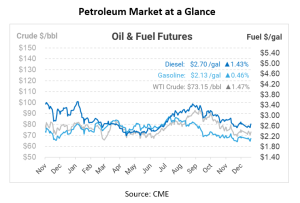
What’s That Wednesday – Carbon Capture Utilization (CCU)
Imagine a world where we not only combat climate change but also turn a pressing environmental challenge such as emissions into a remarkable opportunity. What if I told you there was a transformative technology making that vision a reality that has the power to revolutionize the energy sector, offering a sustainable and economically viable future by capturing and repurposing CO2 emissions? Today’s What Is It Wednesday will be exploring Carbon Capture Utilization (CCU) and how it’s reshaping our energy landscape.
What is carbon capture utilization?
Carbon Capture Utilization (CCU) is a groundbreaking technology that aims to tackle one of the most pressing challenges of our time: reducing carbon dioxide (CO2) emissions from various industrial processes, including power generation, while simultaneously creating value from the captured carbon. Carbon capture is the process of capturing carbon dioxide emissions before they are released into the atmosphere. Various methods are used, such as chemical absorption, adsorption, or membrane separation, to trap CO2 from industrial sources like power plants and factories.
CCU doesn’t stop at just capturing CO2; it’s about finding productive ways to use it. Instead of treating captured CO2 as waste, CCU technologies repurpose it to create valuable products or services.
Why is CCU important for fuel buyers?
The energy sector plays a pivotal role in global carbon emissions, primarily due to the burning of fossil fuels like coal, oil, and natural gas for electricity generation and transportation. CCU presents a range of benefits that are directly relevant to fuel-buying customers and the energy sector as a whole. One of the most significant advantages of CCU is its potential to reduce carbon emissions from power plants and other energy-related processes. By capturing and reusing CO2, we can significantly cut down on the greenhouse gases released into the atmosphere, helping combat climate change.
CCU aligns with the broader goal of transitioning to cleaner and more sustainable energy sources. It provides an intermediate solution for reducing emissions from existing fossil fuel-based infrastructure while renewable energy technologies continue to advance. CCU creates economic opportunities by turning CO2 emissions into valuable products. This includes converting CO2 into fuels, chemicals, building materials, and other high-demand commodities. These products can generate revenue and support job growth in various industries.
How Does CCU Work?
CCU encompasses a wide range of technologies and processes, each with its unique approach to capturing and utilizing CO2. Here are some of the most common CCU methods:
Carbon-to-Value (C2V) Technologies: These technologies convert captured CO2 into valuable products. For example, CO2 can be used as a feedstock for manufacturing fuels like synthetic natural gas or chemicals like methanol. This not only reduces emissions but also contributes to the production of essential products.
Enhanced Oil Recovery (EOR): In this process, captured CO2 is injected into depleted oil reservoirs to enhance oil recovery. EOR not only increases oil production but also stores CO2 underground, preventing it from entering the atmosphere.
Mineralization: This technique involves combining CO2 with minerals, such as olivine or serpentine, to form stable carbonates. These carbonates can be used in construction materials or safely stored underground for long-term carbon sequestration.
Algae Cultivation: Some CCU systems use captured CO2 to grow algae, which can be used for various purposes, including biofuels, animal feed, and wastewater treatment.
Direct Air Capture (DAC): DAC systems are designed to capture CO2 directly from the ambient air. This technology offers the potential to remove historical CO2 emissions from the atmosphere, providing a means to address legacy carbon emissions.
Potential Challenges and Considerations
While CCU holds great promise, it also faces several challenges and limitations, as with any new idea. Some CCU processes can be energy-intensive, potentially offsetting their carbon reduction benefits. Finding ways to minimize energy consumption is essential. Many CCU technologies are still in the experimental or pilot phase and need significant scaling to make a meaningful impact on carbon emissions. The economic viability of CCU depends on the market value of the products generated from captured CO2. Market conditions and policy incentives play a major role in determining its success. Public perception and acceptance of CCU are also critical. Educating the public about the benefits and safety of CCU technologies is essential for their widespread adoption.
Carbon capture technologies for car and trucking emissions are still in the early stages of development and are not yet widely implemented. However, there are ongoing research and pilot projects aimed at exploring the feasibility of applying carbon capture to mobile sources like cars and trucks. Some researchers are exploring the idea of capturing carbon dioxide during the production of alternative fuels, such as synthetic fuels or hydrogen. These fuels can be produced with CCU technologies integrated into the production process.

This article is part of Daily Market News & Insights
MARKET CONDITION REPORT - DISCLAIMER
The information contained herein is derived from sources believed to be reliable; however, this information is not guaranteed as to its accuracy or completeness. Furthermore, no responsibility is assumed for use of this material and no express or implied warranties or guarantees are made. This material and any view or comment expressed herein are provided for informational purposes only and should not be construed in any way as an inducement or recommendation to buy or sell products, commodity futures or options contracts.





